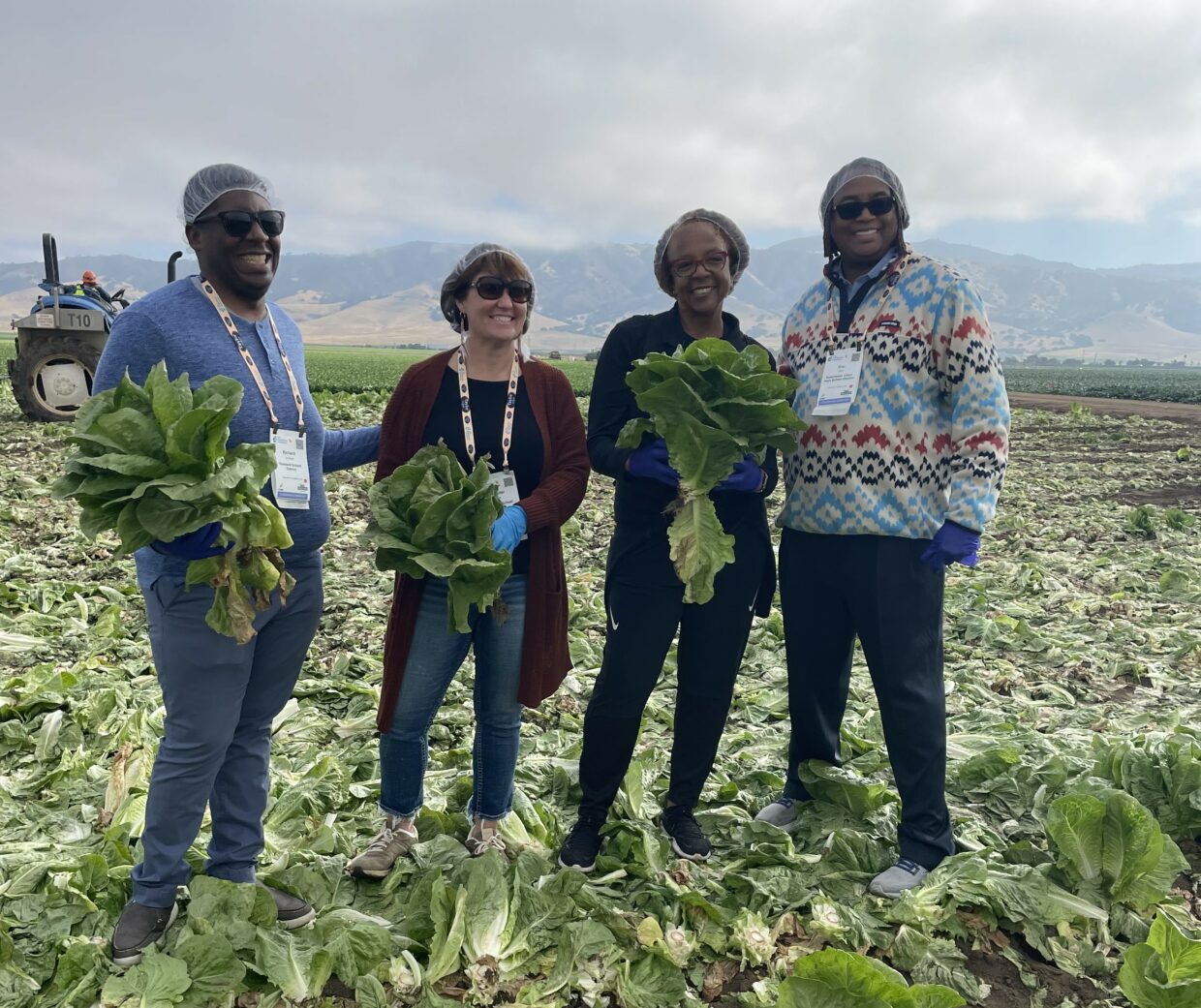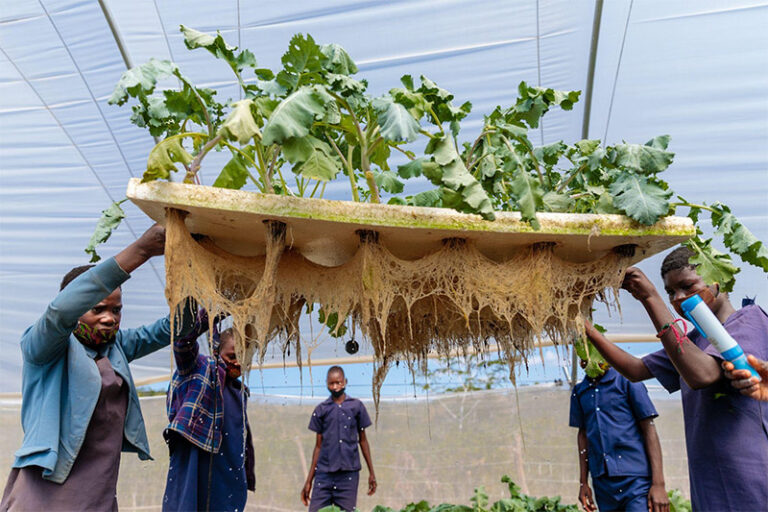K-12 School Nutrition Leaders Serve A Powerful Role In Growing Produce Consumption
Blog by Andrew Marshall, Wholesale-Distributor Relations Manager, International Fresh Produce Association
In the United States, elementary and secondary schools collectively serve more than 30 million meals to children each day. These K-12 schools are large-volume foodservice buyers that can undoubtedly play an outsized role on children’s access, knowledge, and consumption of fresh fruits and vegetables. And with a staggering 9 out 10 Americans not eating recommended levels of fruits and vegetables for better health, schools are an essential partner, as the International Fresh Produce Association (IFPA), and The Foundation for Fresh Produce, seek to nurture passionate fruit and vegetable advocates, allies, and influencers, for growing children’s consumption of the healthiest foods on the planet.
In an effort to support schools to source, serve and promote fresh fruit and vegetables, IFPA has created opportunities throughout the year to connect school menu planners with the produce industry, including at their summer Foodservice Conference & Expo, which takes place each year in the “heart” of the U.S. fruit and vegetable production region of Monterey County, California, also known as the “Salad Bowl of the World.”

In an effort to support schools to source, serve and promote fresh fruit and vegetables, IFPA has created opportunities throughout the year to connect school menu planners with the produce industry, including at their summer Foodservice Conference & Expo, which takes place each year in the “heart” of the U.S. fruit and vegetable production region of Monterey County, California, also known as the “Salad Bowl of the World.”

At the conference, IFPA hosts their K-12 School Foodservice Forum, a programming track that’s designed to create opportunities for ideation, collaboration and discussions between school menu planners and the produce industry. The program is focused on expanding the variety of fresh fruit and vegetables available to children at school by enabling school foodservice operators to connect one-on-one with produce suppliers, visit nearby produce fields, explore new produce and packaging during the IFPA expo, and possibly most impactful, provide an opportunity for school nutrition leaders to spend time with their peers to discuss best practices for incorporating more produce and scratch-cooking into their foodservice operation.
Additionally, by coordinating a program for K-12 menu planners, IFPA looks to guide the industry’s understanding of how schools make menu decisions and procure produce, while also showing that school foodservice operators are valued partners and serious business professionals. IFPA aims to have these foodservice operators leave the conference inspired, more knowledgeable about produce, and excited to be ambassadors for fruit and vegetables when they return to their school kitchens.
IFPA invites school nutrition leaders from across the country, including administrators from leading school foodservice programs, major city school districts, and state agencies, to participate in the K-12 School Forum programming. All K-12 attendees must be senior leaders within their departments, and may include foodservice directors, school chefs, menu planners or other administrators that have responsibility for produce purchasing and/or menu development.

Through the generous support of produce industry sponsors, IFPA has been able to offer scholarships to more than 50 school foodservice leaders each year, helping to cover their travel and related expenses to attend the conference. This support also enables IFPA to offer complimentary conference registrations to all K-12 school menu planners who are interested to attend The Foodservice Conference.
Responsibility to students
“We’re often the largest ‘restaurant’ in town”, said Sandra Kemp, Director of Food and Nutrition Services at the Albuquerque Public Schools in New Mexico. “It’s important to connect in-person with our suppliers, and this conference enables us to take advantage of the location to tour produce fields and see growing and processing operations first-hand. We have a responsibility to our students and the communities we serve, and offering fresh fruits and veggies is a very important part of what we do.”
USDA nutrition standards for school meals require that both a fruit and vegetable be offered, and that students exit their lunch line with at least one serving of produce on their plate. In addition to lunch, many schools also offer breakfast, in-class fresh fruit and vegetable snacks, after-school suppers, and a summer meals program, all of which must include fruit and vegetables.
School meals have undergone significant improvements in recent years. In 2010, Congress passed the Healthy Hunger-Free Kids Act, which updated school meal nutrition standards for the first time in more than thirty years. The legislation also included increased funding to support the healthier meals, while also prioritizing other federal investments in support of these goals. The updates made during this time also coincided with a number of public health intervention strategies spearheaded by the Obama Administration, including the First Lady’s high profile Let’s Move! campaign, which championed increased opportunities for children’s physical activity, school and community gardens, salad bars in schools, and more.
“School districts are looking for the same thing that other foodservice operators are,” said Bertrand Weber, Director of Culinary and Wellness Services at the Minneapolis Public Schools. “It’s important to connect in person with growers and to engage in conversations with our distribution partners as well. Our students and communities count on us to offer delicious, nutritious fresh fruits and veggies, and this conference has become an important learning opportunity for us.”
Bertrand, widely regarded as one of the most influential school nutrition leaders, who transitioned his district’s foodservice operation from a heat and serve operation, under the district’s prior leadership, to one that is now focused on fresh, scratch-made meals that include salad bars and a variety of locally sourced vegetables and other menu items, has attended the IFPA conference several times in recent years. He always comes back with new contacts and ideas, for example, sourcing finger limes and Sumo mandarins for his school district’s participation in the USDA Fresh Fruit and Vegetable Program (FFVP), and when Bertrand does it, other school districts follow his lead. In the months after the IFPA conference, school foodservice across the country were also trying these and similar items in their FFVP program.
“K-12 schools can be a collaborative partner to introduce thousands of schoolchildren to a new produce item, as well as to a variety traditional produce choices on a consistent basis,” said Andrew Marshall, who also leads IFPA’s engagement with the K-12 school nutrition community, and also serves as the association’s liaison for the produce wholesaler-distributor community. “Programs like the K-12 School Foodservice Forum, support school menu planners to continue their efforts to serve more fresh foods, while also encouraging opportunities to ‘push the envelope’ when it comes to new produce choices that can be made available to children at school, or even promoted to parents and their communities,” said Marshall.
Expanding produce variety and knowledge
Diane Grodek, Executive Chef at the Austin Independent School District in Texas, introduced to her students to new items she discovered at last year’s Foodservice Conference. “Attending the IFPA Conference had a direct impact on the menu items my district has planned for the upcoming school year. I was exposed to vendors and produce varieties that I did not even know were an option for my schools. I was able to bring several ideas back to my team, which resulted in seven new fruit and vegetables for our 2024 menus, such as multi-colored fingerling potatoes, multi-colored cherry tomatoes, mini bell peppers, jicama sticks, rainbow baby carrots, and hearty mixes for salads with Brussels sprouts, cabbages and more.”

“These days, in additional to tried and true staples, we’re also looking for fresh-forward options that mimic what students see at restaurants and other outside-the-home dining experiences, and the IFPA conference has helped with that” said Jessica Shelly, Director of Dining Services at the Cincinnati Public Schools. “Yes, we are going to continue offering foods that students are familiar with, but we’re also thinking about how we can elevate our meals, so students are interested and excited to dine with us. Things like washed and de-stemmed cilantro for tacos, new veggie seasonings, or guacamole cups that are great for grab n go. At the end of the day, it’s about nourishing as many students as possible, and as our meal participation increases, this also means we have more in our fund-balance to reinvest in our program, whether that’s for new equipment, a possibly more expensive new food item, or some other enhancement.”
Additionally, the IFPA K-12 School Forum, has created an opportunity to host a full-on produce immersion event for school nutrition operators. In recent years, in addition to produce growers and suppliers, the event has also garnered support from equipment manufacturers and companies that one might call “produce-adjacent”, given how they can support school nutrition operators in their efforts to source, serve and promote fresh produce. Companies, such as those that offer small-scale processing equipment to make fresh salsa, or to quickly peal and process melons, and also sectionizer-slicers that make it easier for schools to serve orange wedges or slice apples or cucumbers. Also, IFPA engaged companies that offer outdoor refrigeration solutions, so schools can expand their ability to store more fresh food on-site. They also arranged to have a company promoting indoor growing towers, which enable students to grow lettuce and fresh herbs that can then be served on the salad bar, used in a culinary classrooms, brought home, and more; essentially an all-around education tool and conversation-starter that puts a focus on fresh produce and herbs.
Additionally, the IFPA K-12 School Forum, has created an opportunity to host a full-on produce immersion event for school nutrition operators. In recent years, in addition to produce growers and suppliers, the event has also garnered support from equipment manufacturers and companies that one might call “produce-adjacent”, given how they can support school nutrition operators in their efforts to source, serve and promote fresh produce. Companies, such as those that offer small-scale processing equipment to make fresh salsa, or to quickly peal and process melons, and also sectionizer-slicers that make it easier for schools to serve orange wedges or slice apples or cucumbers. Also, IFPA engaged companies that offer outdoor refrigeration solutions, so schools can expand their ability to store more fresh food on-site. They also arranged to have a company promoting indoor growing towers, which enable students to grow lettuce and fresh herbs that can then be served on the salad bar, used in a culinary classrooms, brought home, and more; essentially an all-around education tool and conversation-starter that puts a focus on fresh produce and herbs.
Industry leaders take notice, ask questions
The innovations occurring at school are not solely the responsibility and focus of school nutrition operators. A growing number of produce companies are beginning to understand the value of supporting schools to offer a greater amount and variety of fresh fruit and vegetable choices.
According to Alex DiNovo, President & COO of DNO Produce in Columbus, OH, “Schools are an important customer for our business, and having the opportunity to connect with a geographically diverse selection of major city school districts at the IFPA conference is very helpful. These connections enable us to get a greater sense of what’s happening in school foodservice departments across the country, while also getting to showcase our products, and potentially gain some new customers.”
School nutrition operators, like many other segments of the foodservice industry, are experiencing challenges with finding labor, not having enough kitchen staff to cut, chop and prepare all fresh ingredients for the hundreds of meals that an individual school may serve on a daily basis. The IFPA Foodservice Conference is an event, where many of the exhibitors, are showcasing fresh-cut produce options that ensure schools and other foodservice operators can continue to offer fresh produce, despite the issue of limited labor.
“We know schools are looking for fresh-cut solutions”, says Lisa McNeece, Vice President of Foodservice Sales at Grimmway Farms. “Having the ability for them to come to the expo, see our products, and even come by with their distributor partner, enables me to showcase our fresh-cut baby carrots, shredded, coins, sticks and the ever-popular multi-colored baby carrots, and it’s become a very valuable learning opportunity for us all.”
Many of the conference’s industry participants also like the fact that the event takes place nearby their fields and facilities. “The IFPA conference takes place in our hometown, and we’re thrilled to connect with school nutrition leaders who are now attending the IFPA Foodservice Conference because of the K-12 School Forum program,” said Michelle Roberts, Director of Foodservice Marketing at Taylor Farms, a leading grower-shipper processor, based in Salinas, CA. “We have valued the opportunity to host these buyers for tours of our Romaine and broccoli fields, and to show off what we do, but just as important, has been to ask their opinions and get their ideas on how we can better offer products and solutions that meet their needs.”
And of course, some companies are looking for ways to “connect the dots”, not only making their products available in schools, but also looking to introduce children to a specific product or brand that they can then encourage parents to purchase at the grocery store. According to Nancy Johnston, Senior Director of Foodservice Sales at Wonderful Citrus, “At the end of the day, kids are next generation consumers, but they’re also today’s consumer. And with schools serving such a large number of students on a consistent basis, we want to ensure they know about our great tasting mandarins, and then also tell their parents to look for Halos the next time they’re at the supermarket. Working with the K-12 sector isn’t always easy, but it’s a market we can’t afford to ignore.”
Conference expansion, new partnerships
As IFPA looks to grow the impact of the K-12 School Foodservice Forum, this is not only an opportunity to engage new U.S. school nutrition leaders, but also the opportunity to connect with school food operators from other countries. Improving school meals has been a focus in the United Kingdom for some time, Japan and France are two countries that have prioritized school meals as an important part of the education day, and earlier this year Canada announced plans to create a national school lunch program. We know meals can be a reason for students to come to school, and the more we can collaborate to improve the availability, freshness, and quality of school meals, the more opportunity we have to make an impact on the nutrition for the next generation.

Additionally, as part of IFPA’s commitment to supporting K-12 Schools, they also coordinate a mid-year Partner X-Change program that connects school menu planners and produce suppliers for 15-minute “speed dating” conversations. These meetings take place virtually, with 12-15 school operators getting to meet with just as many produce companies over two days. The conversations provide an opportunity for school menu planners to share about their current produce sourcing and give produce suppliers the opportunity to ask questions and share about their products.
In the spirit of arming this influential audience with applicable resources that inspire them to put more produce on menus, IFPA worked with The Foundation for Fresh Produce to develop 10 new plant-forward recipes for K-12 operators that meet the new low-sugar breakfast standards and can be found here.
Bolstering this work, IFPA has also partnered with innovative non-profit organizations, such as Brighter Bites and the Partnership for a Healthier America, both of which are working to grow the prevalence of fresh produce at home. Through a combination of produce donations, recipes, cooking tips and nutrition education, these organizations are making it possible for underserved families to consume more fresh produce, more often, and to expose children and families to fruit and vegetables they may have not otherwise been willing to try. With these programs operating in a number of cities across the United States, their efforts are having a measurable impact.
Ultimately, not eating enough fruit and vegetables is a common challenge, but ensuring these foods are readily available wherever children live, learn, and play, including at school, is an important step toward a healthier future. Partnerships, collaboration, listening, and learning, are all essential for changing the trajectory of human health with fruit and vegetables.
Bolstering this work, IFPA has also partnered with innovative non-profit organizations, such as Brighter Bites and the Partnership for a Healthier America, both of which are working to grow the prevalence of fresh produce at home. Through a combination of produce donations, recipes, cooking tips and nutrition education, these organizations are making it possible for underserved families to consume more fresh produce, more often, and to expose children and families to fruit and vegetables they may have not otherwise been willing to try. With these programs operating in a number of cities across the United States, their efforts are having a measurable impact.
Ultimately, not eating enough fruit and vegetables is a common challenge, but ensuring these foods are readily available wherever children live, learn, and play, including at school, is an important step toward a healthier future. Partnerships, collaboration, listening, and learning, are all essential for changing the trajectory of human health with fruit and vegetables.













No comment yet, add your voice below!